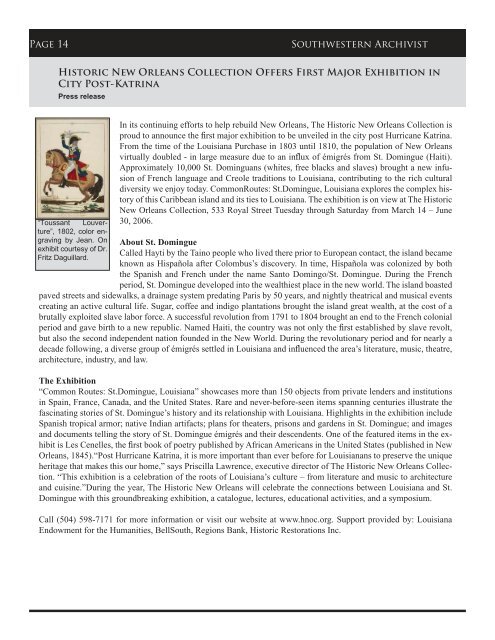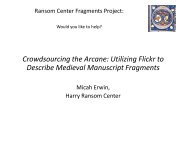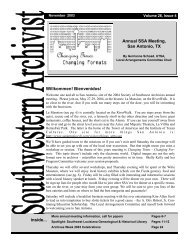Page 14<strong>Southwest</strong>ern ArchivistHistoric New Orleans Collection Offers First Major Exhibition inCity Post-KatrinaPress release“Toussant Louverture”,1802, color engravingby Jean. Onexhibit courtesy <strong>of</strong> Dr.Fritz Daguillard.In its continuing efforts to help rebuild New Orleans, The Historic New Orleans Collection isproud to announce the first major exhibition to be unveiled in the city post Hurricane Katrina.From the time <strong>of</strong> the Louisiana Purchase in 1803 until 1810, the population <strong>of</strong> New Orleansvirtually doubled - in large measure due to an influx <strong>of</strong> émigrés from St. Domingue (Haiti).Approximately 10,000 St. Dominguans (whites, free blacks and slaves) brought a new infusion<strong>of</strong> French language and Creole traditions to Louisiana, contributing to the rich culturaldiversity we enjoy today. CommonRoutes: St.Domingue, Louisiana explores the complex history<strong>of</strong> this Caribbean island and its ties to Louisiana. The exhibition is on view at The HistoricNew Orleans Collection, 533 Royal Street Tuesday through Saturday from March 14 – June30, <strong>2006</strong>.About St. DomingueCalled Hayti by the Taino people who lived there prior to European contact, the island becameknown as Hispañola after Colombus’s discovery. In time, Hispañola was colonized by boththe Spanish and French under the name Santo Domingo/St. Domingue. During the Frenchperiod, St. Domingue developed into the wealthiest place in the new world. The island boastedpaved streets and sidewalks, a drainage system predating Paris by 50 years, and nightly theatrical and musical eventscreating an active cultural life. Sugar, c<strong>of</strong>fee and indigo plantations brought the island great wealth, at the cost <strong>of</strong> abrutally exploited slave labor force. A successful revolution from 1791 to 1804 brought an end to the French colonialperiod and gave birth to a new republic. Named Haiti, the country was not only the first established by slave revolt,but also the second independent nation founded in the New World. During the revolutionary period and for nearly adecade following, a diverse group <strong>of</strong> émigrés settled in Louisiana and influenced the area’s literature, music, theatre,architecture, industry, and law.The Exhibition“Common Routes: St.Domingue, Louisiana” showcases more than 150 objects from private lenders and institutionsin Spain, France, Canada, and the United States. Rare and never-before-seen items spanning centuries illustrate thefascinating stories <strong>of</strong> St. Domingue’s history and its relationship with Louisiana. Highlights in the exhibition includeSpanish tropical armor; native Indian artifacts; plans for theaters, prisons and gardens in St. Domingue; and imagesand documents telling the story <strong>of</strong> St. Domingue émigrés and their descendents. One <strong>of</strong> the featured items in the exhibitis Les Cenelles, the first book <strong>of</strong> poetry published by African Americans in the United States (published in NewOrleans, 1845).“Post Hurricane Katrina, it is more important than ever before for Louisianans to preserve the uniqueheritage that makes this our home,” says Priscilla Lawrence, executive director <strong>of</strong> The Historic New Orleans Collection.“This exhibition is a celebration <strong>of</strong> the roots <strong>of</strong> Louisiana’s culture – from literature and music to architectureand cuisine.”During the year, The Historic New Orleans will celebrate the connections between Louisiana and St.Domingue with this groundbreaking exhibition, a catalogue, lectures, educational activities, and a symposium.Call (504) 598-7171 for more information or visit our website at www.hnoc.org. Support provided by: LouisianaEndowment for the Humanities, BellSouth, Regions Bank, Historic Restorations Inc.
<strong>May</strong> <strong>2006</strong><strong>Southwest</strong>ern Archivist“A Short History <strong>of</strong> Prints:Historical Works <strong>of</strong> Graphic Art”on View at LSUSubmitted by Leah JewettAn exhibit entitled “A Short History <strong>of</strong> Prints: HistoricalWorks <strong>of</strong> Graphic Art” is on view at Hill Memorial Libraryat Louisiana State University, April 17 - September1, <strong>2006</strong>. Works span several centuries, and include a variety<strong>of</strong> techniques including woodcut, lithograph, etching,copper plate engraving, mezzotint, and cliche’-verre,among others. Materials are drawn from LSU LibrariesSpecial Collections and two private collections.Civil War Louisiana to Be Featuredin New PublicationSubmitted by Kathie BordelonThe McNeese State University Archives, Friends <strong>of</strong> theMcNeese Library, and the <strong>Southwest</strong> Louisiana HistoricalAssociation are jointly producing More Stories from OldImperial Calcasieu, a compilation <strong>of</strong> historical articles byMike Jones, writer for the Lake Charles American Press.The book includes articles concerning the Civil War andother war stories and articles about Lake Charles and CalcasieuParish written from 1990 to 2004. The HistoricalAssociation re-printed Mike’s previous articles (1979-1989) in three volumes, <strong>Southwest</strong> Louisiana in the WarBetween the States; Citizen Soldiers: <strong>Southwest</strong> LouisianiansDefend the Nation; and Adventures in Old Calcasieu.SRMA Spring MeetingThe <strong>Society</strong> <strong>of</strong> Rocky Mountain <strong>Archivists</strong> announces itsSpring Conference and Business Meeting to take place atthe Bessemer Historical <strong>Society</strong> in Pueblo, CO on June 2,<strong>2006</strong>. The meeting, entitled, “Still and Moving Images:The Management and Preservation <strong>of</strong> Photographs andFilm” will include talks from Paul Eisloeffel from theNebraska State Historical <strong>Society</strong> and Leslie Shores fromthe American Heritage Center in Laramie, WY.Using a combination <strong>of</strong> real world examples and proventheory, these presenters will discuss still and moving imagesand the issues <strong>of</strong> management, preservation and useassociated with them. For more information, see www.SRM<strong>Archivists</strong>.org or contact: Monte Kniffen (303) 565-5406, archives@redemptorists-denver.org.<strong>Southwest</strong> Collection at Texas techReceives Jaye Skaggs Design, Inc.RecordsSubmitted by Tai KreidlerAn initial donation <strong>of</strong> over 75 boxes <strong>of</strong> materials from Ms.Jaye Skaggs <strong>of</strong> Fort Worth was accepted by Dean Donald Dyalon behalf <strong>of</strong> the <strong>Southwest</strong> Collection at Texas Tech University.The collection contains the business records <strong>of</strong> her interiordesign company. The donation also includes design catalogs,material samples, and publications that cover the broad spectrum<strong>of</strong> the interior design industry.Skaggs is the owner and president <strong>of</strong> Jaye Skaggs Design,Inc., <strong>of</strong> Fort Worth which was an interior design company thatworked with such noteworthy clients as T. Cullen Davis andMartina Navratilova. During the 40 years in business she andher company helped set the standard for ‘Texas’-style interiorsand established world-wide credibility for “Texas chic.”She is also the president <strong>of</strong> HelpBeacon which is a Fort Worth,Texas based corporation that develops products to help locatepeople in both emergency and recreational conditions. Thecompany was founded in 2004 when Skaggs developed a solutionfor 911 callers whose addresses were difficult for emergencyresponders to pinpoint.Skaggs is a native <strong>of</strong> Odessa, Texas and is a graduate <strong>of</strong> TexasChristian University.Also new at Texas Tech: BIG 8 RECORDSThe <strong>Southwest</strong> Collection/Special Collections Library announcedthat Bo Carter, Big 12 Sports Information Director,forwarded the first shipment <strong>of</strong> Big 8 Athletic Conference Recordsto the <strong>Southwest</strong> Collection/Special Collections Library(SWC/SCL) at Texas Tech University. The records will jointhe documents <strong>of</strong> the now defunct <strong>Southwest</strong> Athletic Conferencethat were archived at the SWC/SCL in 1995.In 1994, Texas Tech University, University <strong>of</strong> Texas, Baylorand Texas A&M University joined with members schools <strong>of</strong>the Big 8 to form the Big 12. As a consequence both the Big8 and the <strong>Southwest</strong> Conferences eventually dissolved. Whilethe SWAC Records were archived immediately, the Big 8 Recordshad been in storage since then. Through the <strong>of</strong>fices <strong>of</strong>Bo Carter these documents were preserved and are some <strong>of</strong> thefew Big 8 Athletic Conference Records that remain availablefor research.








